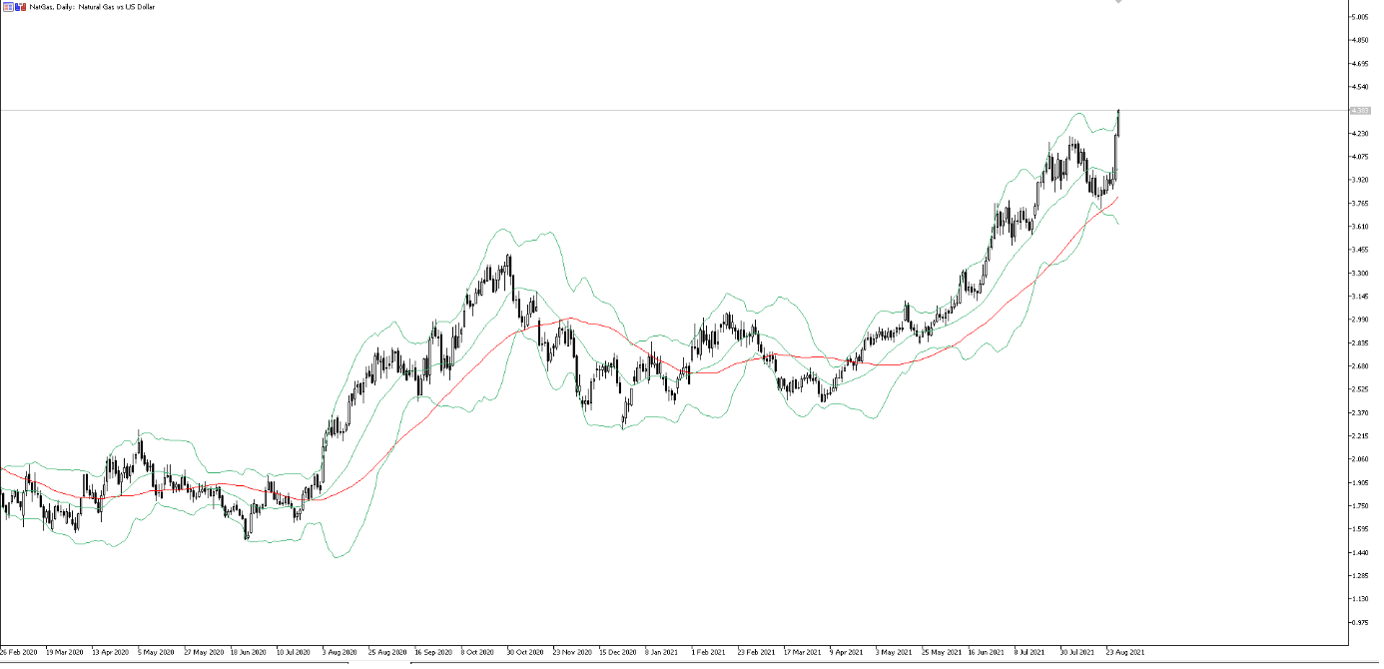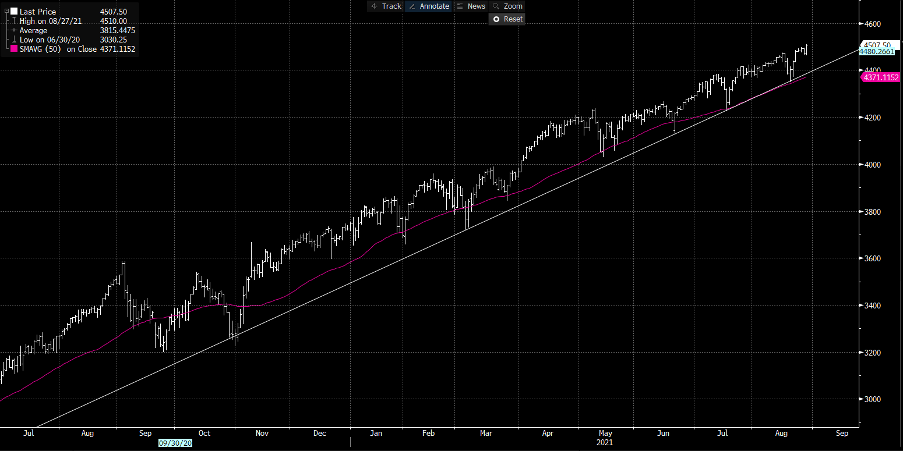- English
- عربي
Trader playbook - OPEC, manufacturing and US payrolls make life very interesting

Asia will have their chance to react to Jay Powell’s Jackson Hole speech and whether they follow on with the broad USD offer (seen on Friday) will be what we react to. Hurricane Ida is front of mind, making landfall and we’re hearing the sizeable majority of production in the Gulf has been shut-in, with refiners in Louisiana unsurprisingly closing. We watch crude for a possible lift and potential close above $70 and this may bring out more momentum-focused traders too.
Nat Gas daily

The XOP ETF (oil and gas producers) closed up 5.3% on Friday and this may be in anticipation of production shut-in’s but there have been strong inflows into the ETF and one to add to the radar. If crude breaks $70, I’d expect XOP to close through $85.00.
Will OPEC increase out as planned?
Trader's will be watching the OPEC+ meeting mid-week, with all the speculation around whether the group ease back on its planned production uplift of 0.4mmbpd per month. There had been some market scuttlebutt that it would be pushed back – another factor, if it were to play out that could lift crude above $70 – the balance of probability is that they will push on with the original plans though.
Consider that on the anticipated global demand and if the run-rate of supply increases continue there will still be a supply and demand deficit this year, a factor underpinning the crude price.
Nat Gas is also flying and requires attention with price at the strongest levels since December 2010.
We also look ahead at manufacturing numbers from China (Tuesday 11:00 AEST – consensus 50.1 from 50.4) and the US (ISM due Thursday 00:00 AEST – 58.5 from 59.5). US CB consumer confidence (due Wednesday at 01:00 AEST) may become more market-moving after the big declines seen in the University of Michigan confidence numbers of late, while US non-farm payrolls (NFP) will be the highlight.
US payrolls the key event risk
The consensus is calling for 750k jobs, which if came to fruition puts the 3-month average at 877k - this average matters a touch more given Jay Powell referenced it on Friday. The unemployment rate is eyed at 5.2%, a 20bp drop from the July print, and again we look not just at the U3 rate but the broader U6 unemployment rate (currently 9.6%), as this is a Fed who are guided by inequality and looking at broad employment trends, which still have some way to go.
There has been much ink spilt on Powell’s speech, so I won't go into huge depth other than to say it’s a strange dynamic playing out – on the employment mandate they are not where they want to be, with many jobs lost through the pandemic still needing to be recouped – Powell is however confident on the future of the labour market, so this week’s payrolls could galvanise that view.
On the other hand, inflation is currently meeting its objectives, but Powell is in the transitory camp and feels price pressures will not be a concern. The introduction of a five-point inflation test was an interesting and meaningful introduction.
Chair Powell wants to see maximum employment before tapering the QE program and if we get an NFP print this week above 800k, with inequality metrics showing promise then we should see November meeting the clear consensus for tapering with the 23 September FOMC offering a strong signal. Another solid read in the September NFP (due 8 October) and the November FOMC will be a slam dunk. Of course, a weak number, say below 550k, muddies the waters and throws a clear air of uncertainty into the mix – the USD will not like that and will be taken to town as real rates likely getting smoked.
The inflationary aspects of Powell’s speech is driving the rates debate and what I feel was the bigger cause of Friday’s move lower in real Treasury yields, the USD and subsequently the solid 1.4% rally in gold and equities, with the Russell 2k +2.9%. There is little doubt Powell was dovish, relative to market pricing and positioning, and we saw bearish reversals play out on the daily in the USDX and USDJPY. Whether this follows through is yet to be seen as one question how much of Friday’s move was positioning that got flushed out.
USD moves – will we see buyers into NFPs?
Can we really trust that this is the start of a renewed bearish trend in the USD when we get payrolls on Friday and the August CPI next week? It is certainly hard to be short the USD for any period of time with any conviction.

(Source: Bloomberg)
We also understand that the week of payrolls is typically a higher volatility affair with the S&P 500 seeing moves (-/+) close to 2% since early 2020. We also know that September is typically the worst month for risk and stocks in particular, although looking at the VIX index (now at 16.39% in spot) you wouldn’t know and few are positioned for a pickup in volatility – that may change, but what would cause a prolonged pullback?
I still feel it comes from a slowing global economy married with a Fed who start to normalising policy, even if they bang the drum that tapering is not tightening. For now, I remain positive on risk with the S&P 500 futures holding the 50-day and uptrend it held through 2021 guiding. There is a focus on the Russell 2k and energy names. Trade the opportunity with Pepperstone.
Related articles
Ready to trade?
It's quick and easy to get started. Apply in minutes with our simple application process.
The material provided here has not been prepared in accordance with legal requirements designed to promote the independence of investment research and as such is considered to be a marketing communication. Whilst it is not subject to any prohibition on dealing ahead of the dissemination of investment research we will not seek to take any advantage before providing it to our clients.
Pepperstone doesn’t represent that the material provided here is accurate, current or complete, and therefore shouldn’t be relied upon as such. The information, whether from a third party or not, isn’t to be considered as a recommendation; or an offer to buy or sell; or the solicitation of an offer to buy or sell any security, financial product or instrument; or to participate in any particular trading strategy. It does not take into account readers’ financial situation or investment objectives. We advise any readers of this content to seek their own advice. Without the approval of Pepperstone, reproduction or redistribution of this information isn’t permitted.
